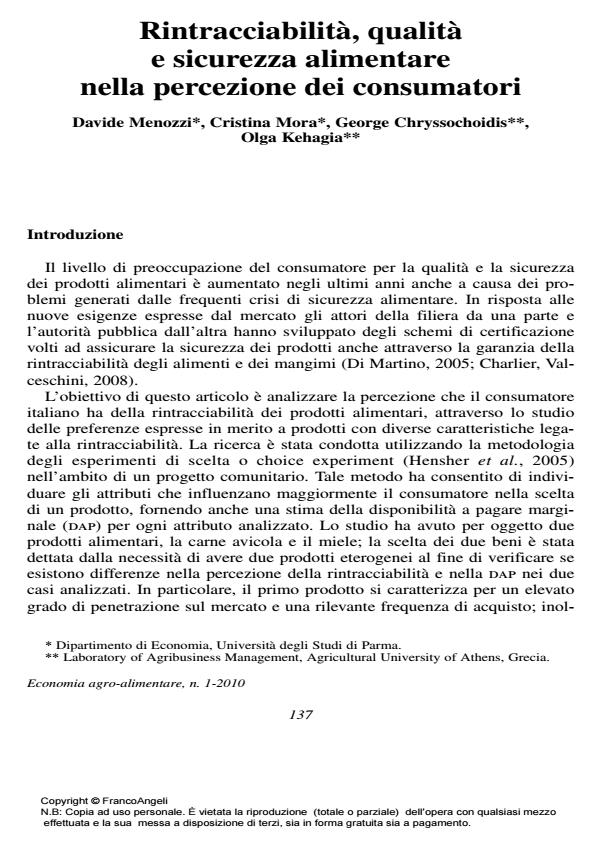Consumers’ perception of food traceability, quality and safety
Journal title ECONOMIA AGRO-ALIMENTARE
Author/s Davide Menozzi, Cristina Mora, George Chryssochoidis, Olga Kehagia
Publishing Year 2010 Issue 2010/1
Language Italian Pages 22 P. 137-158 File size 332 KB
DOI 10.3280/ECAG2010-001008
DOI is like a bar code for intellectual property: to have more infomation
click here
Below, you can see the article first page
If you want to buy this article in PDF format, you can do it, following the instructions to buy download credits

FrancoAngeli is member of Publishers International Linking Association, Inc (PILA), a not-for-profit association which run the CrossRef service enabling links to and from online scholarly content.
In response to consumers’ increasing concerns about food safety, both supply chain operators and public authorities have developed, in the last decade, labelling schemes to provide markets with more information. Although some level of traceability is necessary to provide consumers with valuable information (such as country-of-origin, production process, ecc.), it is not clear so far if traceability per se is important to consumers. The objective of this paper is to analyse consumers’ perception of food traceability with respect to two food products: chicken and honey. More specifically, it aims to provide more insights for both policy makers and supply chain actors into Italian consumer’s perception and preferences for different attributes connected to traceability. After a preliminary qualitative phase, a choice experiment (ce) was employed on a sample of Italian consumers to analyse preferences for different profiles of chicken and honey. ce methodology allows to weight the relative importance of any given attribute for consumers, providing an estimation of their marginal willingness to pay (wtp). A multinomial logit (ml) and a latent class (lc) model were applied to estimate the parameters associated to each product’s attribute. The lc model, in particular, fitted better the data providing more detailed results able to capture heterogeneity of preferences across the considered products. One of the findings in this study is that traceability perception is a product specific issue: consumers have more preferences for traceability attributes in the case of chicken than for honey. This is probably due to a different level of perceived risk and to the higher market penetration of chicken. Therefore, on the one hand, we suggest supply chain operators to develop traceability-based valorisation strategies per product. On the other hand, the introduction of vertical public regulations on food traceability, i.e. defined per product category, should be preferred by public authority.
Keywords: Traceability, choice experiment, latent class model, chicken, honey
Jel codes: C25, D12, Q18
- Honey price estimation for the future in Turkey; example of 2019- 2020 Mustafa Bahadır ÇEVRİMLİ, Mehmet Saltuk ARIKAN, Mustafa Agah TEKİNDAL, in Ankara Üniversitesi Veteriner Fakültesi Dergisi /2020 pp.143
DOI: 10.33988/auvfd.570790 - Trends in EU consumers’ attitude towards fresh-cut fruit and vegetables Antonio Baselice, Francesca Colantuoni, Daniel A. Lass, Gianluca Nardone, Antonio Stasi, in Food Quality and Preference /2017 pp.87
DOI: 10.1016/j.foodqual.2017.01.008 - Motives towards traceable food choice: A comparison between French and Italian consumers Davide Menozzi, Rafia Halawany-Darson, Cristina Mora, Georges Giraud, in Food Control /2015 pp.40
DOI: 10.1016/j.foodcont.2013.09.006 - The Willingness to Pay in the Food Sector. Testing the Hypothesis of Consumer Preferences for Some Made in Italy Products Lucio Cappelli, Fabrizio D’Ascenzo, Maria Felice Arezzo, Roberto Ruggieri, Irina Gorelova, in Sustainability /2020 pp.6275
DOI: 10.3390/su12156275 - Food: Not Only Safety, but Also Sustainability. The Emerging Trend of New Social Consumers Gennaro Civero, Vincenzo Rusciano, Debora Scarpato, Mariarosaria Simeone, in Sustainability /2021 pp.12967
DOI: 10.3390/su132312967 - Assessing the Quality and Floral Variety Market Value: A Hedonic Price Model for Honey Francesco Bimbo, Kristi Nico, Emilio De Meo, in Sustainability /2025 pp.3903
DOI: 10.3390/su17093903
Davide Menozzi, Cristina Mora, George Chryssochoidis, Olga Kehagia, Rintracciabilità, qualità e sicurezza alimentare nella percezione dei consumatori in "ECONOMIA AGRO-ALIMENTARE" 1/2010, pp 137-158, DOI: 10.3280/ECAG2010-001008